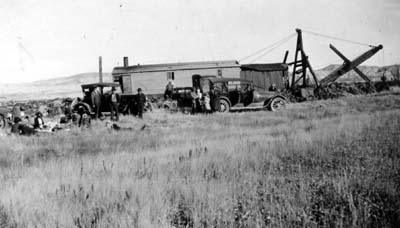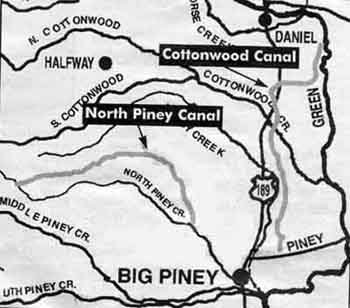The Cottonwood and North Piney Canals
by Helena Linn
Reprinted from The Sublette County Journal, August 26,
1999
 (Photo from the Pearl Spencer collection courtesy
of Bill Budd)
(Photo from the Pearl Spencer collection courtesy
of Bill Budd)
While visiting with Peggy Sage Arnell at the
Big Piney School Reunion this summer, I realized that she and two other
ladies at our table, Barbara Warren from Farmington, New Mexico, and Marilyn
Vickrey, were there because of their common heritage. Peggy's grandfather,
Addison Moffat, was one of the settlers who responded early in this century
to the promotion of the Uinta County Irrigation Company to take up land
under the Carey Land Act near Big Piney, Wyoming. Barbara's father,
Hank Beecher, had been foreman for the crew that had built canals for the
irrigation company. Marilyn's grandparents, the Hakes, had left drought-stricken
Burlingame, Kansas, in 1912 to settle on land in Wyoming where they were
promised that "artificial waterways will give an unfailing water supply,
sufficient at all times, to produce the richest and most abundant crops."
Carey Land Act
Near the turn of the century, agricultural
ground in Sublette County was homesteaded in the valley bottoms, along
streams and rivers wehre irrigation water could easily be routed across
productive pastures and meadowlands. But much of the arid higher
terrain, numbering in the thousands of acres, relied solely on rainwater
to supplement its short growing season.
Because of this challenge to make desert
lands bloom, Joseph M. Carey, a U.S. Senator in the Wyoming Territory,
sponsored the Carey Land Act of 1894, using it as a government-level tool
to lure homesteaders from great distances to purchase and develop these
unproductive lands.
Fields of Dreams
Prompted by the new Carey Act, a company called
the Uinta County Irrigation Company devised a plan to dig two canals in
Sublette County which would bring water to some of the county's desert
lands. The land adjacent to these canals would then be sold for a
profit to would be farmers and ranchers.
A full-page ad about the Uinta County Irrigation
Company appeared in the Marbleton Republican on August 20, 1913.
It announced that 4,000 acres of land in Uinta County (now Sublette County)
would be opened for settlement in conjunction with the construction of
the canals. The ad cited lands "lying under and irrigatable from
the irrigation system known as the Big Piney Canal system and particularly
under the North Piney Canal in the County of Uinta." The company
claimed that it had "acquired its water rights under the North and South
Cottonwood Creeks, South Horse Creek, Muddy Creek, North Piney Creek, and
Green River, all flowing through and adjacent to the Green River Basin."
It further stated that the Cottonwood Canal (leading from the Green River
south of Daniel to the Piney cutoff) was already completed, and that the
North Piney Canal (east of Highway 189) was under construction. In
reality, the Cottonwood Canal had not yet been completed as the company
had claimed.
The company then sent its agent, Mr. Herman,
to the mid-western and southernstates to promote the project. He
told prospective settlers they could buy an 80 or 160-acre farm by paying
from $25 to $35 an acre for a perpetual water right, which was equal to
title to the land. This sum also assured them a proportionate interest
in the irrigation system. To make an entry, they would be required
to pay $3 per acre cash for the $25 land and $5 per acre cash for the $35
land, with the balance divided into ten equal annual payments at 6% interest.
They also were to pay 25 cents per acre to the state when they make an
entry, and 25 cents per acre when they made final proof, which could be
done anytime within three years.
Farmers were assured that the Green River
Basin lands were of a dark sandy loam covered by big, sound, healthy sagebrush,
and were sure to be fertile, and that the lands would not have been opened
up if they weren't up to national and state government standards.
"In ten years time, under the Uinta County Irrigation Company's method,"
the company promised, "you would be a comparatively rich man."
Destination - Wyoming
Mr. Herman convinced several families in Burlingame,
Kansas, to seek a better life in Sublette County along one of the new canals.
Ira
C. Hakes and his family, the Shipley
brothers, the Fisher family, and Carl Craft, were among the discouraged
farmers who decided to risk that Mr. Herman was right.
Among the first to arrive in Sublette County
were J.E. Roberts, E.O. Martin, and Dan R. Storemont from Oklahoma.
Dr. Perkins came from Missoouri, "well equipped with implement and work
stock." Mr. and Mrs. George Wilson, from Dearborn, Missouri, brought
with them a "carload of effects, such as cows, pigs, chickens, and several
splendid teams, and are thoro farmers," according to the April `13, 1913
issue of the Big Piney Examiner.
Over the next year, the Examiner and
the Republican printed many news items, referring to people who
took up land on the ditch project. In one, "Johnnie Matthews and
Chas. Rathbun brought a number of land hungry home seekers up from the
road (Opal and the railway) to view the lands." In anothr item, the
family of C.W. Carlson had moved into their new home built under the Cottonwood
Canal. Mr. Carlson had one of the best crops of oats in the valley,
convincing him he came to the right country to settle.
Faded Dreams
It soon became apparent to the settlers, however,
that they had ventured into a project that was doomed to fail. Because
the Uinta County Irrigation Company was unable to complete the canal system,
within a couple of years the settlers found they were trying to live on
unproductive land with no irrigation water and a very short growing season.
Perhaps what proved to be the company's least conceivable clain was, "Within
the coming year, we expect a railroad to be built within thirty miles of
the Uinta County Irrigation Company's lands."
Beginning of the End
Further, the irrigation company had been
unable to acquire all the right-of-ways through private property.
Therefore the water which meant to give life to the land, legally was unavailable
to the settlers. Work on the Cottonwood Canal was halted as the ill-fated
project began to fall apart.
By February, 1915, people were beginning
to leave a country they had hoped to love. The Big Piney Examiner
reported that "Mr. and Mrs. Dan Storemont will leave for Oklahoma,
having sold all of their household goods and livestock the past week."
Cottonwood Land and Livestock, managed by settler Wm. E. Carlin, was selling
its cattle and hay to T.D. Oneil. And though Mr. Carlin had made
his own desert land entry in 1911 and filed his notice of intention to
make final proof in 1914, he wrote in 1915 to ask that the Examiner
be sent to Los Angeles, which was now his permanent address.
An Examiner ad for rollerskating
at the Auditorium in Marbleton showed that proprietor Frank
Shipley had turned to other enterprises. He already had started
a brick kiln. Mr. Shipley's wife died a few years after they applied
for land on the project. He remarried and spent the rest of his life
contracting and ranching in the Big Piney area.
Some of the houses built by the farmers
in the settlement were abandoned; others were moved. The Gilhausen
house was moved into Big Piney and became the home of George
and Elaine Moffat. The Roberts house was moved into Marbleton
where the family continued to live for several years. Joe Murdock
and Caryn Bing remember that their family bought and moved one of the houses
to use as a ranch bunkhouse. Another went to the Wardell Ranch.
Among the settlers making a decision to
stay in the area were the families of Addison Moffat, George and Mabel
Wilson, and Dr. Perkins. They all had filed on land in Meadow Canyon
where they were able to irrigate the land. Bill (Mother) Williams
worked on ranches and rode for the cattlemen's associations, earning a
reputation as a good cook and pro card player. Charles Fultz settled
on Cottonwood. Roxie MClintock, who lived on the Gutherie Place,
cooked for the roundups - a fantastic dutch oven cook according to Gordon
Mickelson.
The Hakes' daughter, Opal, married Bill
Ray. Mr. and Mrs. Hakes moved to Washington, but Opal
and Bill remained and raised their family. Effie Stout married
Sylvester Griggs, who had a garage and managed
the electric company in Big Piney for many years. George Moffat served
as cashier and officer of the State Bank of Big Piney. Grace Moffat
met and married Joe Sage, who had ridden into the country on hourseback
from Encampment. They raised their family on land that they bought
from Floyd Norris at the edge of Marbleton. Mabel Wilson married
Gus Erickson after George died and operated Erickson's
Cafe for a long time. Hank Beecher, the company's agent, took
up his own land. The other agent, Mr. Herman, stayed in the area
for several years.
The Last Days
On November 22, 1915, the Big Piney Examiner
published the notice that the Uinta County Irrigation Company, with
all property, rights, titles, and interests, would be offered for sale
to the highest bidder.
In the 1930s, Jim Mickelson acquired
the project from John Hay and finally completed the work begun so many
years before. Despite early days frustrations and disappointments,
the canals which were meant to irrigate the "undeveloped empires of agriculture,"
today supply several ranches along their banks.
Whether or not the irrigation project was
a land scam, or built on a shaky foundation with the best of intentions,
will never be known.




